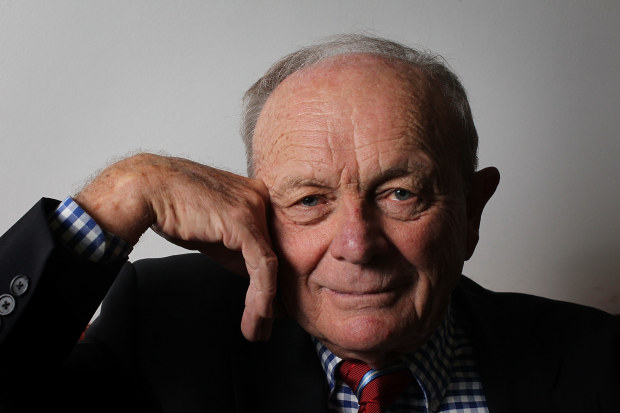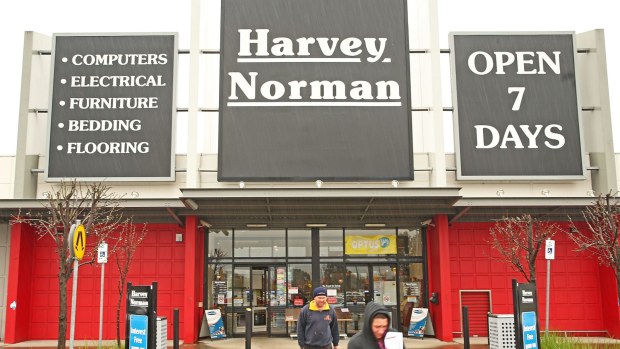Chanticleer

The billionaire says the consumer is holding up, Wesfarmers was “conned” with Catch Group and one property sector is white hot.
Billionaire Gerry Harvey is as irrepressible as ever.
Shares in his retail giant Harvey Norman might have been belted after it delivered its first-half results on Tuesday, but Harvey is certain the market has got it wrong.
“My advice to you is sell your house, sell your boat, sell your car, put the lot into Harvey Norman [shares] and then ring me in three or four years, and you won’t need to be a journalist any more,” he tells this columnist.

Harvey Norman executive chairman Gerry Harvey says warehouses are in short supply pushing values up. Ben Rushton
Harvey used a similar line in February 2018, when the stock was trading around $3.65; it would climb to $6 in March 2021, but closed down 7.5 per cent to $3.85 on Tuesday after the company disclosed like-for-like sales in January were down 10.4 per cent.
But Harvey reckons the stock is worth “six to eight bucks”.
First, he argues the December half result needs to be seen in the context of an incredible few years; while reported profit was down 15.1 per cent to $365.9 million, profits have surged more than 71 per cent since the first half of 2020, the last “normal” period before the pandemic struck.
But Harvey also says the market is badly underestimating the value of Harvey Norman’s property portfolio, which is in the books at $3.9 billion, up $107 million following net revaluations during the half; a quarter of the properties were revalued by external valuers in the half.
“There is no value attributed to that whatsoever. In fact, it works a bit the opposite way, where they start to question the value of our property.”
Harvey has a point.
The group’s net tangible assets sit at $3.90 a share, and the company has a market value of $4.8 billion; either the retail business, which turned over $3.5 billion in Australia alone in the December half, is worth just $800 million, or investors don’t believe its property portfolio is worth anything like the company says it is.
The treatment of Harvey Norman’s property has been a long-standing gripe for the billionaire and an issue of contention for the market; he reminds me of a column that I wrote four years ago raising questions about the way the portfolio was valued, and points out that since then, its value has increased by 56 per cent.
But Harvey believes even Harvey Norman is undercooking what the portfolio is worth, for one very simple reason: scarcity.
‘A conservative bloke’
“I’ve got 30 people working in my property department trying to find sites. I can’t find a site virtually in Australia,” he says. “If I do find one, the cost of the land has not dropped, it’s going up as I speak – there’s no sign of land prices dropping in retail and warehousing – and the cost of building is now 20 per cent dearer than two years ago.”
His property team reckons that if the individual properties were put on the market, they would likely fetch $5 billion.
Harvey says he’s a conservative bloke, so he’s more comfortable with a $4.5 billion valuation. Either way, he argues there’s a serious gap that the market is missing.
“The property is more valuable than platinum and gold – but it’s not regarded as that.”
If you’re not already calling your local real estate agent to sell your home to buy Harvey Norman shares, you might accuse Harvey of a touch of hyperbole.
But his effective suggestion that the bulky goods sector is the hottest property market in Australia did get support during profit reporting season from BWP Trust, the listed real estate group that owns a huge portfolio of bulky goods centres that house Bunnings stores and other retailers.
Amid widespread pressure on valuations across the listed sector, BWP booked a $54 million valuation gain, which was attributed to an improvement in rental growth and steady capitalisation rates or investment yields, which remained just above 5 per cent.

Gerry Harvey says the value of Harvey Norman’s property portfolio is grossly undervalued by the market. Scott Barbour
Harvey says the combination of a scarcity of sites for bulky goods retailers, and a swing back to bricks and mortar retail after the pandemic, makes Harvey Norman’s property portfolio a particular source of strength heading into the retail sector’s “new normal”.
He says online-only retailers, who were “crowing out there a year or two ago about how they were going to take over our business”, are looking much less smug now.
“If you’re an online-only retailer now, your chances of survival are slim – it doesn’t matter who you are.”
He’s particularly critical of Wesfarmers for the conglomerate’s acquisition of, and subsequent investment in, online marketplace Catch Group, which Harvey claims will never work.
“They were conned. Catch has cost them half-a-billion, and it will cost them another half-a-billion before they close it down.”
If Harvey is excited about his retail property portfolio, investors appear to be more focused on what falling residential property prices mean for sales of furniture, white goods and consumer electronics.
Two tiers of spending
Monthly CoreLogic data released on Wednesday shows Australian national average home prices fell 0.1 per cent in February, their 10th monthly fall in a row. From their peak in April 2022, national home prices are down 9 per cent, the biggest fall on CoreLogic records back to 1980.
Harvey is sanguine about the retail outlook. Yes, sales have slowed, but the three-year view says Harvey Norman has enjoyed impressive growth and consumers can keep spending.
“At the moment, I’m looking at the consumer and thinking, we’ve got full employment. The top 20 per cent of the population are spending as big and strong as ever,” pointing to strong sales at Harvey’s privately held thoroughbred sales business, Magic Millions, and high-end furniture retailer, Space.
This gels with other anecdotal evidence of two tiers of consumer spending that was provided during reporting season by the likes of Coles Group and Treasury Wine Estates, which both said spending on higher-value products was holding up, while spending on cheaper items was patchy.
Perhaps the most vivid example of this was Domino’s Pizza, which saw its share price smashed after revealing sales of cheap pizza had slowed after it increased fees and charges to offset inflation.
The fact that Sydney house prices actually ticked up in February after falling 13.8 per cent since last April may add to the argument that top-end spending could be surprisingly resilient.
Bagikan Berita Ini














0 Response to "Gerry Harvey says this is Australia's hottest property market - The Australian Financial Review"
Post a Comment